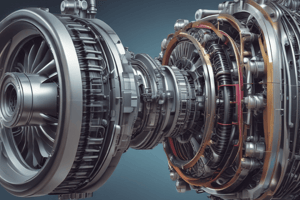Podcast
Questions and Answers
Efficiency measures the useful work done by a machine compared to the work needed to operate it.
Efficiency measures the useful work done by a machine compared to the work needed to operate it.
True (A)
Mechanical Advantage is calculated by dividing the output force by the input force.
Mechanical Advantage is calculated by dividing the output force by the input force.
True (A)
The formula for calculating Work is Force x Distance.
The formula for calculating Work is Force x Distance.
True (A)
Potential Energy only involves motion.
Potential Energy only involves motion.
Friction is created when two objects slide past each other without any contact.
Friction is created when two objects slide past each other without any contact.
IMA of a lever is calculated by input length divided by output length.
IMA of a lever is calculated by input length divided by output length.
The input force is sometimes called the effort force.
The input force is sometimes called the effort force.
The ideal mechanical advantage considers the effects of friction in its calculation.
The ideal mechanical advantage considers the effects of friction in its calculation.
Examples of contact forces include gravity and magnetism.
Examples of contact forces include gravity and magnetism.
A crumb falling from the table is an example of kinetic energy.
A crumb falling from the table is an example of kinetic energy.
Water behind a dam is an example of potential energy.
Water behind a dam is an example of potential energy.
Flashcards are hidden until you start studying
Study Notes
Formulas and Definitions
- Formula for Force of Gravity: mass of object × strength of Earth's gravitational field
- Formula for Efficiency: (useful output work ÷ input work) × 100%
- Formula for Ideal Mechanical Advantage (IMA): Input distance ÷ output distance
- Formula for IMA of a lever: L in ÷ L out
- Formula for IMA of an inclined plane (ramp): Length of ramp ÷ height of ramp
- Formula for Mechanical Advantage: Output force ÷ input force
- Formula for Work: Force × distance (or F × D)
Types of Forces
- Contact forces: forces that act through physical contact between objects (e.g. racket hitting a tennis ball, puck sliding on ice)
- At-a-distance forces: forces that act without physical contact between objects (e.g. gravity, magnetism)
Energy
- Kinetic Energy: energy of an object in motion (e.g. a person walking, a crumb falling from a table)
- Potential Energy: energy stored in an object that can be used to do work later (e.g. water behind a dam, a fruit before it falls)
Mechanical Advantage and Efficiency
- Mechanical Advantage: the amount by which a machine can multiply an input force
- Efficiency: the ratio of useful work done by a machine to the work needed to operate it
Simple Machines
- The six simple machines are: pulleys, wheel and axles, levers, inclined planes, screws, and wedges
Work and Machines
- Work: the amount of effort spent when a force causes an object to move a distance
- Machines make work easier by reducing the force required to accomplish a task
- Input force is also known as the effort force
Studying That Suits You
Use AI to generate personalized quizzes and flashcards to suit your learning preferences.




